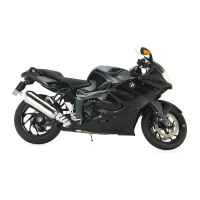The sensor 1 in the shift linkage
detects the shift request and ini-
tiates shifting support.
When driving at constant speed
in low gears at high engine
speeds, upshifting without clutch
operation can result in major
load change reactions. , BMW
Motorrad recommends only
upshifting with clutch operation
in these driving situations. The
shifting assistant should not
be used in the area of the rev-
limiter.
No shifting support is provided in
the following situations:
during shifting with engaged
clutch
during shifting with the throttle
valve closed (overrun)
during downshifts
Brakes
How is the shortest
braking distance
achieved?
The dynamic load distribution
between the front and rear wheel
changes during braking. The
heavier you brake, the more
the front wheel is loaded. The
greater the wheel load, the more
braking force can be transferred.
To achieve the shortest possible
braking distance, the front brake
must be applied quickly and with
increasing force. This optimal-
ly utilizes the dynamic load in-
crease on the front wheel. At the
same time, the clutch should al-
so be actuated. With the "forced
braking" often practiced in which
the brake pressure is generat-
ed as quickly as possible and
with great force, the dynamic
load distribution cannot follow
the increased deceleration and
the braking force cannot be com-
pletely transferred to the road
surface. To prevent the front
wheel from locking, the ABS sys-
tem must intervene and reduce
the brake pressure; the braking
distance increases.
Descending mountain
passes
There is a danger of the
brakes fading if you use on-
ly the rear brakes when descend-
ing mountain passes. Under
extreme conditions, the brakes
could overheat and suffer severe
damage.
Use both front and rear brakes,
5
76
z
Riding

